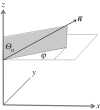Order and gelation of cellulose nanocrystal suspensions: an overview of some issues
- PMID: 29277736
- PMCID: PMC5746553
- DOI: 10.1098/rsta.2017.0038
Order and gelation of cellulose nanocrystal suspensions: an overview of some issues
Abstract
Cellulose nanocrystals (CNCs) are polydisperse rod-shaped particles of crystalline cellulose I, typically prepared by sulfuric acid hydrolysis of natural cellulose fibres to give aqueous colloidal suspensions stabilized by sulfate half-ester groups. Sufficiently dilute suspensions are isotropic fluids, but as the concentration of CNC in water is increased, a critical concentration is reached where a spontaneously ordered phase is observed. The (equilibrium) phase separation of the ordered chiral nematic phase is in competition with a tendency of the CNC suspension to form a gel. Qualitatively, factors that reduce the stability of the CNC suspension favour the onset of gelation. The chiral nematic structure is preserved, at least partially, when the suspension dries. Solid chiral nematic films of cellulose are of interest for their optical and templating properties, but the preparation of the films requires improvement. The processes that govern the formation of solid chiral nematic films from CNC suspensions include phase separation, gelation and also the effects of shear on CNC orientation during evaporation. Some insight into these processes is provided by polarized light microscopy, which indicates that the relaxation of shear-induced orientation to give a chiral nematic structure may occur via an intermediate twist-bend state.This article is part of a discussion meeting issue 'New horizons for cellulose nanotechnology'.
Keywords: cellulose nanocrystals; chiral nematic phase; desulfation; gelation; twist-bend structure.
© 2017 The Author(s).
Conflict of interest statement
I declare I have no competing interests.
Figures
Similar articles
-
Twist-Bend Stage in the Relaxation of Sheared Chiral Nematic Suspensions of Cellulose Nanocrystals.ACS Omega. 2016 Aug 18;1(2):212-219. doi: 10.1021/acsomega.6b00100. eCollection 2016 Aug 31. ACS Omega. 2016. PMID: 31457126 Free PMC article.
-
Chiral Nematic Structure of Cellulose Nanocrystal Suspensions and Films; Polarized Light and Atomic Force Microscopy.Materials (Basel). 2015 Nov 18;8(11):7873-7888. doi: 10.3390/ma8115427. Materials (Basel). 2015. PMID: 28793684 Free PMC article.
-
The development of chiral nematic mesoporous materials.Acc Chem Res. 2014 Apr 15;47(4):1088-96. doi: 10.1021/ar400243m. Epub 2014 Apr 2. Acc Chem Res. 2014. PMID: 24694253
-
A review of nanocrystalline cellulose suspensions: Rheology, liquid crystal ordering and colloidal phase behaviour.Adv Colloid Interface Sci. 2020 Jan;275:102076. doi: 10.1016/j.cis.2019.102076. Epub 2019 Nov 19. Adv Colloid Interface Sci. 2020. PMID: 31780045 Review.
-
Recent Advances in Chiral Nematic Structure and Iridescent Color of Cellulose Nanocrystal Films.Nanomaterials (Basel). 2016 Nov 14;6(11):213. doi: 10.3390/nano6110213. Nanomaterials (Basel). 2016. PMID: 28335340 Free PMC article. Review.
Cited by
-
New horizons for cellulose nanotechnology.Philos Trans A Math Phys Eng Sci. 2018 Feb 13;376(2112):20170200. doi: 10.1098/rsta.2017.0200. Philos Trans A Math Phys Eng Sci. 2018. PMID: 29277748 Free PMC article. No abstract available.
-
Understanding Nanocellulose-Water Interactions: Turning a Detriment into an Asset.Chem Rev. 2023 Mar 8;123(5):1925-2015. doi: 10.1021/acs.chemrev.2c00611. Epub 2023 Feb 1. Chem Rev. 2023. PMID: 36724185 Free PMC article. Review.
-
Colloidal Behavior of Cellulose Nanocrystals Grafted with Poly(2-alkyl-2-oxazoline)s.ACS Omega. 2019 Jul 9;4(7):11893-11905. doi: 10.1021/acsomega.9b01269. eCollection 2019 Jul 31. ACS Omega. 2019. PMID: 31460300 Free PMC article.
-
UV-Triggered On-Demand Temperature-Responsive Reversible and Irreversible Gelation of Cellulose Nanocrystals.Biomacromolecules. 2020 Feb 10;21(2):830-838. doi: 10.1021/acs.biomac.9b01519. Epub 2020 Jan 28. Biomacromolecules. 2020. PMID: 31940433 Free PMC article.
-
Cellulose: A Review of Water Interactions, Applications in Composites, and Water Treatment.Chem Rev. 2023 Mar 8;123(5):2016-2048. doi: 10.1021/acs.chemrev.2c00477. Epub 2023 Jan 9. Chem Rev. 2023. PMID: 36622272 Free PMC article. Review.
References
-
- Revol J-F, Godbout L, Dong XM, Gray DG, Chanzy H, Maret G. 1994. Chiral nematic suspensions of cellulose crystallites; phase separation and magnetic field orientation. Liq. Cryst. 16, 127–134. (10.1080/02678299408036525) - DOI
-
- Dong XM, Gray DG. 1997. Effect of counterions on ordered phase formation in suspensions of charged rodlike cellulose crystallites. Langmuir 13, 2404–2409. (10.1021/la960724h) - DOI
-
- Dong XM, Kimura T, Revol J-F, Gray DG. 1996. Effects of ionic strength on the phase separation of suspensions of cellulose crystallites. Langmuir 12, 2076–2082. (10.1021/la950133b) - DOI
-
- Dong XM, Revol J-F, Gray DG. 1998. Effect of microcrystallite preparation conditions on the formation of colloid crystals of cellulose. Cellulose 5, 19–32. (10.1023/A:1009260511939) - DOI
Publication types
LinkOut - more resources
Full Text Sources
Other Literature Sources



 …
… 